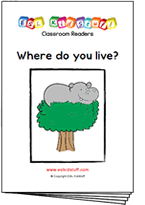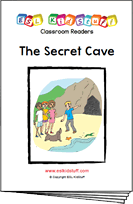Places & where we live lesson plan
Stand-alone lesson ESL kids lesson plan
Lesson plans for ESL kids teachers
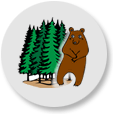
Places & where we live
A lesson plan for talking about where animals and people live. In this lesson students practice the structures of “Where do you live?” and “I live …”, and are shown how to use the prepositions “in” and “on” for places. It ends with a fun class poster craft activity.
Members get accompanying flashcards, worksheets, song and classroom reader.
Download materials:
Our lesson plans are FREE!
Sign up for accompanying:
✔ worksheets
✔ homework sheets
✔ craft sheets
✔ flashcards
✔ song downloads & videos
✔ classroom readers & videos
Click to see lesson details, materials and supplies
Time: 40 mins – 1 hour
Objectives: Talking about where animals and people live.
Structures: “Where do you live?”, “Where does (a cow) live?”, “I live (in/on) …”, “It lives (in/on) …”.
Target vocabulary: fish, cow, bear, camel, bat, duck, goat, hippo, sea, farm, forest, desert, cave, lake, mountain, river, city, town, village, countryside.
Lesson materials
Flashcards:
- fish, cow, bear, camel, bat, duck, goat, hippo, sea, farm, forest, desert, cave, lake, mountain, river, city, town, village, countryside
Printables:
- Where do you live? song worksheet
- Where do you live? write worksheet
- Reader worksheet
- Where do you live? song poster
Songs:
- Where do you live?
Readers:
- Where do you live?
Additional materials:
- Places where we live vocab crossword
- Places where we live vocab word search
- Our homes worksheet
Supplies:
- [hide_on_uk]colored[/hide_on_uk][hide_on_us]coloured[/hide_on_us] pens
- large sheet of construction paper / card
- blank paper (1 per student)
- craft supplies (e.g. glitter, cotton wool, etc.) – this is optional
- scissors
- glue
- Blu-Tack or something to stick flashcards to the board
- board with marker / chalk
- device to play the song on
This lesson teaches students to ask where people (and animals) live using the structure “Where do you live?”. Students also practice saying where they live using the prepositions “in” and “on”.
Lesson procedure:
Warm up and maintenance:
The beginning of your lesson is extremely important: this is where you set the tone of your lesson and get everyone in the right frame of mind for learning English. It is also an opportunity to check homework and review previous lessons.
Click for warm up suggestions for the start of your lessons
These activities can be done in the following order at the start of your lesson:

1. Greetings and name tags
Greet the students by name as they enter the classroom and gesture for them to sit down. Before class prepare some blank name tags (stickers or pin-on tags). Give these out and have everyone write their names and put their tags on. If you use pin-on tags, you can keep and give out every class.

2. Homework check
Check each student’s homework set in the last lesson. Ask each student some questions about their homework worksheet (e.g. “what [hide_on_uk]color[/hide_on_uk][hide_on_us]colour[/hide_on_us] is it?”), give lots of praise, and then put some kind of mark on the homework sheet (e.g. a sticker, a stamp or draw a smiley face). Finally, tell your students to put their homework back into their bags.
3. Review past lessons
Reviewing past lessons is very important – students need constant practice of new vocab, structures, songs, games and so on. Always review parts of your last lesson as well as some parts from other previous lessons. You can spend 5-10 minutes reviewing – it’s fine to recycle games and activities from your past lessons to review as kids enjoy playing familiar games (although be careful not to play a game to death!). See the section “Other ideas to include in your warm” below for ideas.
You can also include review activities in the main body of your lesson. Kids can have short attention spans so it’s good to be able to pull out lots of activities during different stages of the lesson.
Other ideas to include in your warm up:
Ball pass questions
This is good to review questions from previous lessons. Get everybody standing in a circle.
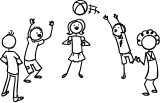
Round 1:
Take a ball and hold it and say, “My name is (you name)”. Then throw the ball to one student and say, “What’s your name?”. Students throw the ball around randomly, saying their names and asking for names.
Round 2:
This time ask a review question, e.g. “How many tables are there?”. Then throw the ball to a student who should answer, “There are (6) tables”. Help if necessary. Then that student throws the ball to another student and asks a “How many …?” question. Continue so everyone has a go. You can have multiple rounds with different topic questions.

Play “Spin the bottle”
Sit students in a circle with a bottle in the middle. Teacher spins the bottle. When it stops spinning the student it is pointing to has to answer a question. If the answer is correct then that student can spin the bottle. This is a good class warm up activity (e.g. How are you? What’s your [hide_on_uk]favorite[/hide_on_uk][hide_on_us]favourite[/hide_on_us] food? How’s the weather today?, etc.
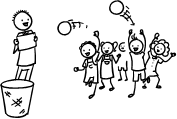
Play “Vocabulary basketball”
This is a fun game which reviews vocabulary from previous lessons. You will need a basket (a trash can) and 2 balls (or 2 pieces of A4 paper scrunched up into balls).
Form 2 teams and line them up so that two players from each team are facing the front with the basket in front of them. Let both players throw their ball – if they get their ball into the basket they can try and win a point by giving the correct answer to a question the teacher asks. This can be an actual question (e.g. What are you wearing?) or a flashcard (What’s this?). Then they go to the back of the line. At the end, the team with the most points is the winner!
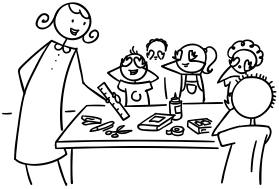
Play “What’s missing?”
This is a fun review memory game – students will have to try to remember review objects from previous lessons (e.g. classroom stationery). Lay the objects out on a table for all to see. Allow the students a minute to memorize the positions of the objects. Remove an object and hold it behind your back. Say, “Open your eyes!” – the first student who can shout out the missing object wins a point for his/her team. Play for all the objects.
Finally, calculate which team has won the most points and give them a round of applause.

Play “Quiz game show”
This is a fun quiz game, like a simple version of a TV game show. Draw some circles on the board and randomly write numbers 1, 2 or 3 in each circle. These will be points.
Put students into teams. Then ask the first team to choose a number – 1 is an easy question (e.g. “Do you like bananas?”) and 3 is a difficult question (e.g. point at a clock and ask, “What time is it?”). 2 will be in between in terms of difficulty. When the question has been answered correctly, erase that number circle. Play until all the number circles are gone – the team with the most points is the winner!
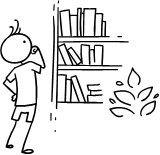
Read a classroom reader again
As you progress through the lessons you will start to build up a catalog of classroom readers (see our Readers download page at https://www.eslkidstuff.com). Kids love going back to old stories and reading through them again. Invite a student to pick a classroom reader and read through it as a class. Make the story as interactive as possible by asking questions (e.g. what [hide_on_uk]colors[/hide_on_uk][hide_on_us]colours[/hide_on_us] there are, the names of different objects, etc.) and getting students to speculate what is going to happen next in the story.

Talk about the weather (do after you have taught the weather lesson plan).
- Prepare a weather board. Before the first class prepare a piece of cardboard and cover it with felt – you are going to pin this to the wall. If you can, try and get blue felt (to represent the sky). Write at the top in large letters, “How’s the weather today?”. Below that write “Today it’s”. Cut out weather pictures (such as our weather flashcards) and stick some velcro on the back. Arrange the weather pictures around the edge of the board and then put the board on the wall of your classroom. You can now use this weather board at the beginning of every lesson.
- Ask about the weather. Ask, “How’s the weather today?” and have students put up their hands. Allow one weather condition per student (e.g. “It’s rainy”) and have each student come up and put a weather picture on the weather board.
- Introduce more weather vocabulary. Depending on weather conditions, you can introduce more weather words (with pictures … you can get students to draw them), such as:
- stormy
- misty
- showery
- freezing
- humid
- frosty
- icy
- drizzly
New learning and practice:
1. Review animal vocabulary – play “What animal am I?”
The song that you are going to sing later in the lesson covers two different vocabulary areas: animals and places. At this stage your students should have covered some animal vocabulary so this can be a review of many of those animals.
Before class, print out the animal flashcards for fish, cow, bear, camel, bat, duck, goat, hippo. Also add any other animals your students have studied in previous lessons.

Start by modeling: look at a flashcard but don’t show anyone. Then act out that animal (also doing sounds), for example, walking on all fours saying “moooo!” (for cow). Students can put their hands up if they know the answer. Select a student – if he/she answers correctly he/she can do the next animal – show a flashcard and have them do the action. Again, the student who answers correctly can do the next animal. Continue until all the animals have been guessed.
Finally, stick the flashcards on the board. Put everyone in pairs to take turns in acting out and guessing the animals.
2. Teach the vocabulary for places
Remove any animal flashcards from the board that are not in the song and then arrange the remaining animal flashcards in a column from the left-top of the board to the left-bottom (see board layout image below). Make sure the animals are NOT in the order of the song if you are going to do the listening worksheet (as they will be listening for the correct order).
Board layout:

Next take the places flashcards and stick them randomly onto the right-side of the board. You are creating a matching activity on the board – students will need to match the places to where the animals live.
Start with the first animal (e.g. a cow) and say, “Hmm. Where does a cow live?”. Gesture to the places pictures on the right. Point to the “sea” flashcard and ask, “Does a cow live in the sea?”. Make it obvious that this is a crazy idea. Try pointing to a few more places flashcards until everyone has told you the correct card (a farm). Hold the farm flashcard up and chorus it 3 times. Place the farm flashcard next to the cow flashcard and write next to them, “A cow lives on a farm” and chorus 3 times.
Then, select a student to come to the board and stick the correct place flashcard next to the 2nd animal. If correct, praise the student and ask him/her to sit back down. Chorus the place 3 times, write the sentence on the board and chorus that 3 times. Continue until all the animals have places flashcards next to them.

You should still have 4 places flashcards remaining on the right-side of the board: city, town, village, countryside.
Under the last animal flashcard draw a stick man. Say, “I” and point to yourself. Point to each of the remaining places flashcards and chorus them. Stick all 4 next to the stick man and write 4 sentences:
- I live in a city
- I live in a town
- I live in a village
- I live in the countryside
Chorus all four sentences. Then, say where you live (e.g. pointing at the town flashcard say, “I live in a town”). Then go around the class, asking student where they live and having them all use the correct structure. Help out with the meanings of these words (e.g. a city is very, very big, a village is small, etc. – you can use place names familiar to your students, such as “Tokyo is a city”).
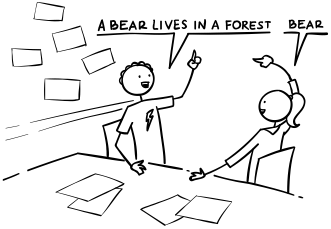
Now that you have all of the vocabulary and structures on the board, let’s practice. Put all students in pairs. Student A says an animal (or the word “I”) randomly, and their partner has to say the sentence (reading from the board). For example:
Student A: “A goat.”
Student B: “A goat lives on a mountain.”
Get students to swap roles after each sentence. After a few minutes, explain that the students are going to test each other. Pairs sit facing each other – one student with his/her back to the board. The other student says an animal and listens to their partner saying the full sentence (he/she should help and correct if necessary). Make sure all students have a go at being tested.
3. Play the “Flashcards race” game
You will need 2 sets of the animals and places flashcards. Have everyone stand up and divide the class up into two teams – get each team to line up on either side of the classroom. Take the 2 sets of flashcards and shuffle each set. Scatter one set on the floor, face down, on the right-side of the classroom and do the same with the other set on the left-side of the classroom.
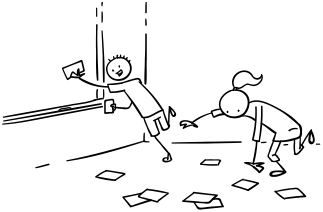
Now for the game: the first “player” from each team will have to race to find the correct cards and stick them on the board, according to your instructions. For example, shout, “The bat lives in a cave”. The players from each team will run to their flashcards on the floor and turn them over until they find the “bat” and “cave” flashcards, then run to the board and stick them next to the sentence “A bat lives in a cave.” (from point 2 above). Make sure that they leave all the flashcards on the floor turned face down.
Then continue with other students. Each time, the first student to place the correct flashcards next to the correct sentence on the board wins a point for his/her team.
Alternative #1: for fun, do silly sentences, such as “The hippo lives in a forest”.
Alternative #2: instead of putting the cards next to the sentence on the board, erase the sentences before starting the game. Each student then has to find the correct cards, put them on the board, and write the sentences correctly.
4. Sing the “Where do you live?” song
You can either have everyone sing and dance along to the song or use our song worksheet as a listening task. Please see Gestures below for full instructions.
Lyrics for “Where do you live?”
Chorus:
Where do you live?
Where do you live?
Where, oh where, oh
Where do you live?
Verse 1:
I am a fish, I live in the sea.
I am a cow, I live on a farm.
I am a bear, I live in a forest.
I am a camel, I live in a desert.
Chorus
Verse 2:
I am a bat, and I live in a cave.
I am a duck, I live on a lake.
I am a goat, I live on a mountain.
I am a hippo and I live in a river.
Chorus
Verse 3:
I live, I live, I live in a city.
I live, I live, I live in a town.
I live, I live, I live in a village.
I live, I live, I live in the countryside.
Gestures for “Where do you live?”
During the song, student can either dance and do gestures, or complete a listening task worksheet:
- For gestures: students dance to the song and act as the animals in the song.
- For the listening worksheet: give a copy of the “Where do you live? song worksheet” to everyone. Chorus the vocab and explain that everyone has to listen to the song to complete the sentences. Play the song 2-3 times until everyone has completed the worksheets. If your students enjoy the song, play once more with everyone dancing and doing animal gestures.
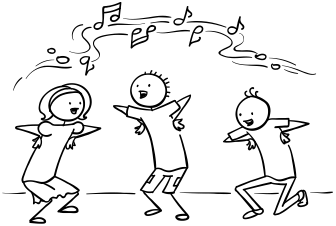
[hide_on_uk]Short sample (members get full-length song):
[/hide_on_uk]
[hide_on_us]Short sample (members get full-length song):
[/hide_on_us]
5. Read classroom reader “Where do you live?”
Before class, download and print off the reader “Where do you live?”. As you go through each page, point to the pictures and elicit the different animals and where they are. For each animal it will first show a place that they do not live (e.g. a duck in a shoe) and then on the next page the correct place (a duck on a lake). In each case, ask your students if the animal is shown in the right place and then get them to shout out where they think they should live, for example:
Teacher: (pointing to the picture of the duck on page 1) What animal is this?
Students: A duck!
Teacher: Yes, that’s right! And what [hide_on_uk]color[/hide_on_uk][hide_on_us]colour[/hide_on_us] is this duck?
Students: Yellow!
Teacher: Yes! And where is the duck? (pointing at the shoe)
Students: In a shoe!
Teacher: Yes, a shoe – very good! Does a duck live in a show? (looking very doubtful)
Students: No!
Teacher: That’s right! A duck doesn’t live in a shoe. Where does a duck live?
Students: On a lake?
Teacher: Let’s check. (Reading) “I am a duck. Do I live in a shoe?” (Turns page) “No! I live on a lake”. You were right! Good job!

Get the students really involved in the story by asking lots of questions such as what colors the animals are and the objects they are shown in.
Alternatively, watch our video version of the reader (Internet connection required).
6. Create an “Animal habitats” wall poster
We’ll end with a fun craft activity in which everyone creates a classroom poster. You will need a large sheet of construction paper / card for the poster sheet (as big as possible). Give everyone a piece of blank A4 paper, [hide_on_uk]colored[/hide_on_uk][hide_on_us]coloured[/hide_on_us] pens, scissors and any other craft supplies you may have (e.g. glitter, cotton wool, etc.).
Give everyone a task – to draw, [hide_on_uk]color[/hide_on_uk][hide_on_us]colour[/hide_on_us] and cut out an animal or place (use the ones from the song) to stick onto the poster. Depending on the number of students you have you may need to give more than one picture for each student to do. Just make sure that all 8 animals and places are being made.
After everyone has drawn and cut our their pictures, get them to work together to glue the pictures onto the poster. For example, the student who created the bear and the student who created the forest will have to make sure they stick their pictures together so the bear is on the forest picture.
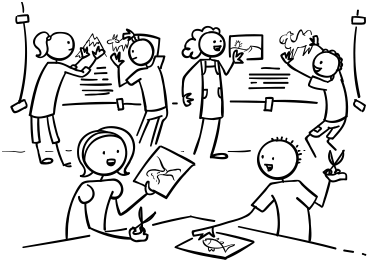
Finally, have the students draw speech bubbles next the pictures they have made and write inside the speech bubbles where animals live (e.g. “I am a fish. I live in the sea”).
Put the poster on the wall and give lots of praise as you go talk about their pictures. In future lessons, you can use this wall poster as a review exercise.
Wrap up:
Assign homework: “Where do you live? write” worksheet
Click for wrap up suggestions for the end of your lessons

1. Assign homework
Each week give out a homework worksheet for your students to take home. Hold up the homework worksheet and model how to do it. Give out the worksheets and say, “Put your homework in your bags”.

2. Do “Quick check”
Time to leave the class. Make sure everything is put away and the students have gathered their belongings. Have them line up at the door and place yourself between the door and the students. For each student check one new word or phrase, for example:
- hold up an object or flashcard (such as an item of clothing) and ask, “What’s this?”
- ask a question from the lesson (e.g. “Where do you live?”, “Do you like bananas?”, “Can you play chess?”, etc.)
When they give you the correct answer say goodbye and let them leave. If their answer is wrong, have them go back to the end of the line – they will have to try again once they reach the front!
Other lesson plans
Actions, verbs & tenses:
- Can – for ability
- Morning routines
- Daily routines & times of the day
- Actions – Present continuous
- Future plans using “going to”
- Past tense activities – Regular verbs
- Past tense activities – Irregular verbs: Part 1
- Past tense activities – Irregular verbs: Part 2
Adjectives:
- Describing people
- Describing things
- Comparing things (Comparative adjectives)
- Comparing things (Superlative adjectives)
Adverbs:
Alphabet:
Animals:
Body:
Classroom:
Clothes:
Colors:
Colours:
Directions:
Family:
Feelings & emotions:
Food:
Health & sickness:
Holidays & festivals:
Jobs:
Likes, dislikes & favorites:
Likes, dislikes & favourites:
- Likes & dislikes
- [hide_on_uk]Favorites[/hide_on_uk][hide_on_us]Favourites[/hide_on_us] and asking why
Nature & Our world:
Numbers:
Places & where we live:
Prepositions of location:
Pronouns:
Shapes:
Shopping:
Sports:
Time, days, months, seasons:
Toys:
Transport & travel:
Weather:


